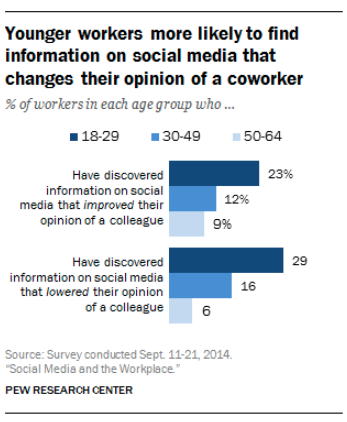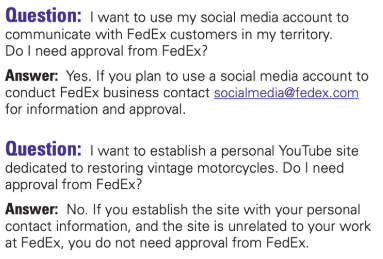A social media policy is a crucial tool for any organization that uses social media.
In fact, it’s a crucial tool even if your organization doesn’t use social media. Because your employees almost certainly do: 72% of Americans use at least one social media platform. Yet 63% of Americans say their employer has no social media policy.
A social media policy isn’t just a set of rules. It guides, advises and inspires in best and worst case scenarios.
Not sure where to start? Read on.
Table of contents
What is a social media policy
Why are social media policies important?
What to include in a social media policy
How to write a social media policy
Social media policy examples
Bonus: Get a free, customizable social media policy template to quickly and easily create guidelines for your company and employees.
What is a social media policy?
A good social media policy is a living document that provides guidelines for your organization’s social media use. It covers your brand’s official channels, as well as how employees use social media, both personally and professionally.
Social media is in constant flux. Networks and functionality change, new platforms emerge, and others fall. Your social media policy can’t just sit quietly< in a drawer (or a Google Doc.).
And it shouldn’t matter if the person reading it is a new hire or a social media manager in the middle of a PR crisis. You need a straightforward, up-to-date document that is easy to understand and act on.
Why are social media policies important?
Maybe you’ve skirted some social media issues already. Or maybe your social media strategy is going swimmingly. Either way, why go to the trouble of crafting, revising and launching an official social media policy for your organization?
There are a few compelling reasons. An official policy can help you:
- Maintain your brand identity across channels
- Treat legal and regulatory sensitivities with awareness
- Prevent a security breach
- Prevent a full-blown PR crisis
- Act fast if a crisis or breach does happen
- Be upfront with your employees about their own social media responsibilities
- Encourage your employees to own and amplify your brand’s message
What to include in a social media policy
1. Define your team’s roles
Who owns which social accounts? Who covers which responsibilities on a daily, weekly or as-needed basis? It might be helpful to include names and email addresses so that employees from other teams know who to contact.
Responsibilities to assign might include:
- Daily posting and engagement
- Daily customer service
- Strategy and planning
- Advertising
- Security and passwords
- Monitoring and listening
- Approvals (legal, financial, or otherwise)
- Crisis response (see #3)
- Social media training for other employees
At the very least, this section should establish who can speak for your brand on social media—and who can’t.
2. Establish security protocols
There are a lot of social media security risks out there. In this section you have the opportunity to provide guidance on identifying and dealing with them.
How often do your account passwords get changed? Who maintains them, and who has access to them? Is your organizational software updated regularly? What about devices? Who should employees talk to if they want to escalate a concern?
3. Make a plan of action for a security or PR crisis
The goal of your social media policy is to prevent the need for a social media crisis management plan.
But it’s best to have both. Consider whether these should be two separate documents—especially if your social media policy will be public-facing.
Your crisis management plan should include an up-to-date emergency contact list with specific roles. The social media team, legal and PR experts—all the way up to the C-suite.
Guidelines for identifying the scope of the crisis, an internal communication plan, and an approval process for response will also help you handle it as quickly as possible.
4. Outline how to stay compliant with the law
Details will vary from country to country, or even state to state, so consult your legal counsel. At minimum your policy might touch on the following:
- Copyright isn’t a no-brainer, so it’s best to explain how to comply with copyright law on social media, especially when using third-party content.
- Privacy is key. Do all your employees know how to handle customer information, for instance?
- Confidentiality refers to respecting your organization’s internal information. Whether you have your people sign non-disclosure agreements or not, they should be aware of the ramifications of disclosing information on social media that the organization considers private.
5. Provide guidance on how employees behave on their personal social media accounts
According to Pew, only 32% of Americans report that their employer has a policy about how they present themselves online. (Although 51% have a policy about using social media at work—which your policy can also cover, if you like.)
Posting hate speech, threats of violence, harassment, or racial epithets on social media may violate the law, or your organization’s code of ethics, or both. Regardless, employees should know that they will be held responsible for what they say.
Even when the posts in question aren’t outright illegal, it might be interesting for your employees to think about how 17% of American workers admit they use social media to find out more about the people they work with. And they’re more likely to find information on social media that lowers their opinion.

6. Encourage employees to take part in conversations around your brand
Your social media team probably speaks your brand’s voice in their sleep. And your official spokespeople are drilled to answer tough questions on the fly. But what about everyone else? How do they stay accountable to your organization?
You may wish to ask employees to post disclaimers stating their relationship with your organization, and that their opinions are their own. For instance, Adidas encourages employees to identify themselves and “make clear that you are speaking for yourself and not the Adidas Group.”
Meanwhile, Walmart asks that employees avoid engaging in conversations about Walmart entirely. Of course, that doesn’t apply to former employees:
As a former Walmart employee, I can tell you this isn’t at all a rare occurrence. Our store use to have a gentleman who would ride his scooter around all night eating whole rotisserie chickens and never paid for them. He was finally arrested after who knows how many chickens.
— C (@CasoLaso) July 2, 2019
For more guidance and inspiration on how to encourage your organization’s employees to advocate for your brand on social media, check out our Employee Advocacy Toolkit.
How to write a social media policy
In five simple steps:
1. Download our social media policy template
It’s free and it asks all the questions you need to get started.
2. Seek input from stakeholders
Your organization’s power users, HR team, and public spokespeople probably have some key ideas that will help round out your unique needs. The most crucial consultation, of course, will be with your legal team.
Pro tip: as you draft your policy, don’t get caught up in tutorials or details. The nitty-gritty will inevitably change, and fast. Focus on the big picture.
3. Decide where your policy will live
We highly recommend adding your policy to your employee handbook, so that new hires can read (and enjoy!) it during onboarding.
But where will existing employees access it? Will it live on your company intranet, or shared drives? Depending on your organization’s needs, you may consider posting it to your external website, as well.
4. Launch it (or relaunch it)
Whether it’s a revision or a brand new document, you’ll want to make sure everyone is aware that it’s ready for their eyes. Whether you announce it via internal email or at an all-hands meeting, make sure you leave plenty of room and opportunity for questions.
5. Flag it for review at this time next year
It’s not uncommon to see social media policies that date back to the dark ages of 2013 or 2011. (You can tell because they use neat buzzwords like “Web 2.0” and “microblogs.”)
Committing to an annual or biannual review will make sure your policy stays useful and relevant. At the very least, you’ll want to ensure all the details and contact information are up to date.
And when you make adjustments, don’t forget to note the date of revision somewhere within the document.
Social media policy examples
While your brand’s social media policy probably isn’t going to make headlines by enacting six-figure fines for tweets, here are some other high-stakes, best-in-class examples.
Adidas Group
This breezy, respectful and permissive one sheet (ok, two sheet) is a clear and direct code of conduct that encourages employees to engage online, but also reminds them of their responsibilities—not just as employees, but humans.
FedEx
FedEx has a lot of employees on the ground, and this visually appealing set of guidelines includes a lot of practical, real-world FAQs to keep everything as clear as possible for them.
Mayo Clinic
As one would expect from a trusted healthcare brand, this policy places special emphasis on patient-employee interactions, privacy, and confidentiality.
Dell
A simple and straightforward policy, with sound advice for anyone using social media: “…remember to have conversations rather than push agendas.”
Reuters
A thoughtful, well-written policy that acknowledges the risks as well as the necessity of social media for journalists and media professionals. This type of policy has a high opinion of its audience’s decision-making abilities, and is less prescriptive than educational, or even ethical.
US Air Force
While you’d expect the military to be on the restrictive side when it comes to policy, the US Air Force’s guidelines for its service members surprisingly focus on how useful social media is for keeping in touch with family and telling individual stories for a wider audience.
General Motors
GM built out a long and short version of their policy, and even the long version is impressively clear for such a thorough document.
Hootsuite makes it easy to protect your brand across all social channels. From a single dashboard you can easily manage permissions, approve posts, edit messages, take advantage of compliance and security tools, and more.
